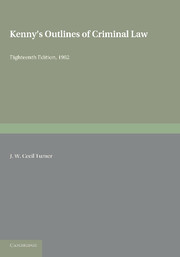Book contents
- Frontmatter
- Preface to the Sixteenth Edition
- Preface to The Seventeenth Edition
- Preface to the Eighteenth Edition
- Contents
- Index of cases
- Index to the principal statutes
- List of principal books cited
- BOOK I GENERAL CONSIDERATIONS
- CHAPTER I CRIME AND CRIMINAL LAW
- CHAPTER II PRINCIPLES OF CRIMINAL LIABILITY
- CHAPTER III VARIATIONS IN LIABILITY
- CHAPTER IV PRELIMINARY CRIMES
- CHAPTER V THE POSSIBLE PARTIES TO A CRIME
- CHAPTER VI THE CLASSIFICATION OF CRIMES
- BOOK II DEFINITIONS OF PARTICULAR CRIMES
- BOOK III MODES OF JUDICIAL PROOF
- BOOK IV CRIMINAL PROCEDURE
- Appendix I The meaning of ‘credit’
- Appendix II II Rules as to admission of evidence which reveals to the jury facts discreditable to the person accused
- Appendix III III Forms of indictment
- Index
CHAPTER I - CRIME AND CRIMINAL LAW
from BOOK I - GENERAL CONSIDERATIONS
Published online by Cambridge University Press: 05 June 2016
- Frontmatter
- Preface to the Sixteenth Edition
- Preface to The Seventeenth Edition
- Preface to the Eighteenth Edition
- Contents
- Index of cases
- Index to the principal statutes
- List of principal books cited
- BOOK I GENERAL CONSIDERATIONS
- CHAPTER I CRIME AND CRIMINAL LAW
- CHAPTER II PRINCIPLES OF CRIMINAL LIABILITY
- CHAPTER III VARIATIONS IN LIABILITY
- CHAPTER IV PRELIMINARY CRIMES
- CHAPTER V THE POSSIBLE PARTIES TO A CRIME
- CHAPTER VI THE CLASSIFICATION OF CRIMES
- BOOK II DEFINITIONS OF PARTICULAR CRIMES
- BOOK III MODES OF JUDICIAL PROOF
- BOOK IV CRIMINAL PROCEDURE
- Appendix I The meaning of ‘credit’
- Appendix II II Rules as to admission of evidence which reveals to the jury facts discreditable to the person accused
- Appendix III III Forms of indictment
- Index
Summary
Section I. THE NATURE OF A CRIME
DIFFICULTY OF DEFINITION
The definition of a crime has always been regarded as a matter of great difficulty. The problem was discussed by Professor Kenny in his first edition of this work, and his exposition ever since has been regarded with careful consideration in any approach to the question. Where the task of definition is difficult it is advisable that a student should not address himself to it until he has acquired some considerable knowledge of the subject-matter to be defined. Professor Kenny's original chapter was therefore reproduced as an appendix in the last edition followed by a brief note of some points of criticism to which it has been subjected. The truth appears to be that no satisfactory definition has yet been achieved, and that it is, indeed, not possible to discover a legal definition of crime which can be of value for English law. The reasons for this are to be found in the history of our common law.
TORT AND CRIME
Writers on English legal history have often mentioned that in early law there was no clear distinction between criminal and civil offences. The two have been called ‘a viscous intermixture’, and it has been explained that the affinity between tort and crime is not in the least surprising when we remember how late in the history of law there emerged any clear conception of a difference between them; this is, moreover, not a peculiarity of the English system, as was pointed out by Sir Henry Maine. There is indeed no fundamental or inherent difference between a crime and a tort. Any conduct which harms an individual to some extent harms society, since society is made up of individuals; and therefore although it is true to say of crime that it is an offence against society, this does not distinguish crime from tort. The difference is one of degree only, and the early history of the common law shows how words which now suggest a real distinction began rather as symbols of emotion than as terms of scientific classification.
- Type
- Chapter
- Information
- Kenny's Outlines of Criminal Law , pp. 1 - 6Publisher: Cambridge University PressPrint publication year: 2013



